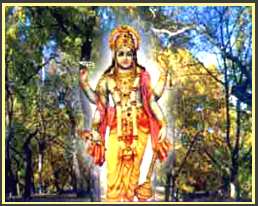About 50/60 years back this temple was established. We can worship Sri Lakshmi Narasimha here. The Lord is gracing with Sri Lakshmi on His left lap. Srimad Azhagiyasingar visits this place and blesses the devotees. From here we go to Sri Devaraja temple nearby. Sri Kanchi Varadaraja is gracing in Naimisharanyam, for a long time. We are welcomed by the Sri Rama sthupa raised during Sri Rama Yagna performed by Sri Sri Tridandi Sriman Narayana Jeer. After worshiping at Dwajasthambam, we go inside. We first worship Sri Thayar Sri Maha Lakshmi. The mantapa where Sri Thayar is gracing is very beautiful. She is seated with right hand showing Abhaya and left hand pointing to Her Divine feet. We go round the temple. Swami Ramanuja is gracing seated. Nearby, we can also worship Tirumangai Alwar. In the garbhagruham, Sri Devaraja is gracing. Like in Kanchipuram, the Lord is holding discus and conch in the upper hands, lower right hand is in Varada mudra, promising to grant all the devotees desire, and lower left arm holding mace. Sri Utsavar is with Sri Ubhaya Nacchiyar, with lower right hand in Varada mudra and lower left arm as Kati hasta. One wonders, whether He is Sri Srinivasa of Tirumala or Sri Devaraja of Kanchi.

Outside, all the ten pasurams of Tirumangai Alwar on this Kshetram, are engraved in Devanagari script, with commentaries in Hindi. In one pasuram Alwar says that instead of remembering the Lord in the mind and not uttering His names in the mouth, many had lived; but we also know what was their fate. To avoid that, Alwar says that he had come to surrender to Him, Who is like poison to Asuras and Amrut to Devas, at Naimisharnyam. Now we will see sloka 39. Sri Krishna has been describing the types of Sukham. He explained that Satvika Sukham was the real happiness and permanent. Initially, it might be difficult like poison, but gradually, it becomes like Amrut. In contrast, Rajasa Sukham will be sweet to start, but gradually turns out to be poison. Now He is to explain Tamasa Sukham. This would be poisonous to start and in the end also it would be like poison! Can we call that sukham or happiness? If an experience is bitter sometimes, but sweeter some other times, then people might call it as sukham. Then, how can an experience which is initially bitter, and continues to be bitter till end, as sukham? The reply lies in sloka 39:
yad agre cānubandhe ca sukhaṃ mohanam ātmanaḥ
nidrālasyapramādotthaṃ tat tāmasam udāhṛtam 18.39
Tat = that [sukham or happiness], udahrtam = is called, tamasam = Tamasa [Sukham]. Yad = which [sukham] is, agre ca = initially and, anubandhe ca = at the end, mohanam atmana = deludes atman. This will confuse atman to understand one for another. This sukham emanates from, nidra = sleep, alasya = laziness, pramada = carelessness, uttam = originated. We have to see how the sukham emanating from sleep, laziness and carelessness, is Tamasa Sukham. Firstly, all these Three help in reducing Gyana or intellectual power. They will never induce in development of Gyana. More we sleep, less will be growth of Gyana. More laziness means less development of Gyana. More carelessness, Gyana will not grow. Real sukham is when Gyana grows. After sleep, we think we are fresh. Because, we think that the body and organs are tired and so sleep woud refresh them. After all if tiredness is removed, it is happiness. So we assume sleep is happiness. If someone wakes us up in the middle of sleep, we get angry. That is we think our happiness is interrupted. But actually, night is called Triyama; that is night is of Three Yaamams [Three hours is one Yaamam यामम] duration. We should sleep only for Two Yaamams. Shastras say that person sleeping only for Two Yaamams will be greatly benefitted. Therefore, excessive sleep can never be for happiness. So, Sri Krishna tells that over sleeping makes a person dull and so is not happiness. Laziness is also misunderstood as sukham. Not performing the prescribed duties or not studying, but remaining idle, might look like happiness. For office goers, weekend is holiday. Immediately, we want to idle the weekend, by not doing our duties. Next is carelessness. If we want to do an action, we have to be careful in following proper procedure and methods. To be careful, involves effort and perhaps, some strain also. So we assume carelessness is freedom and so happiness. Thus all these Three are false happiness and not real. With this we are to take leave of Naimisharanyam. In this Kannanin Aaramudu serial, so far we have visited 105 Divya Desams. The only remaining Divya Desams are Dwaraka, Tirupparkadal and Vaikuntam. We will see how to enjoy these Kshetrams also.
No comments:
Post a Comment